#loose ends three
Explore tagged Tumblr posts
Text
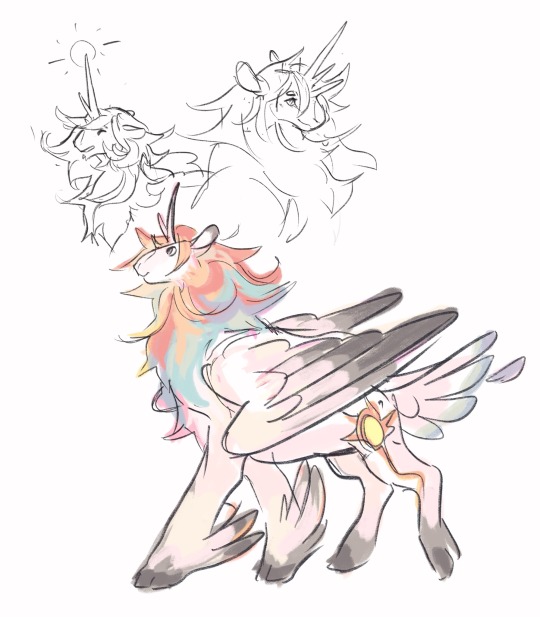

What if I redesigned some horses to fit MY favorite narrative trope: fallen gods and forgotten myths of old? Anyways.
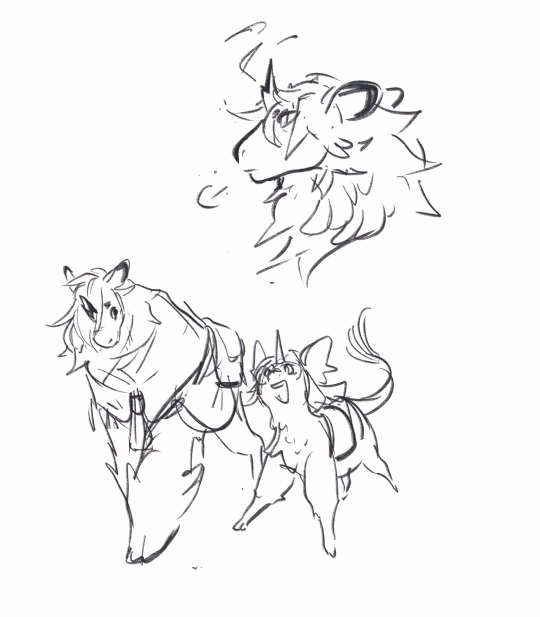
Twilight’s mentor is a strange one. In a world of twilit planes forever shrouded in mystery, the older unicorn Lest and her adopted student Twilight are one in many common travelers, migrating the pitted wastelands and eeking survival within settlements that spring up around the glowing meteor shards. Despite living with Lest for the last four years, Twilight can’t help but seek answers to where her brother has gone— and in the process, perhaps dig a bit too deeply into the complexities of gods far older and dangerous then she can truly fathom.
On the otherhand, Celestia “Lest” Sol is having a terrible millenium. Her sister is no longer her sister, her student teleported herself halfway across the continent, and she got herself kidnapped by an old rival trying to attune with the elements of harmony to overthrow the current ruler of Equestria.
At least she gets a toxic yuri moment.

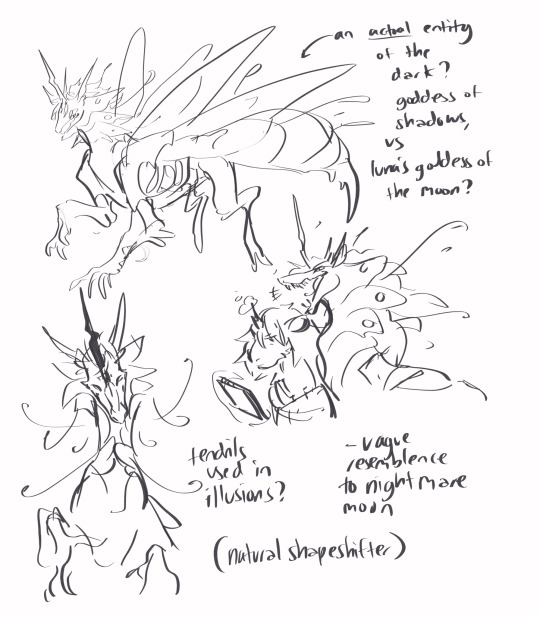
Meanwhile, Chrysalis is having a great time. She’s got kingdoms to conquer and people to feed and a waning god to taunt.
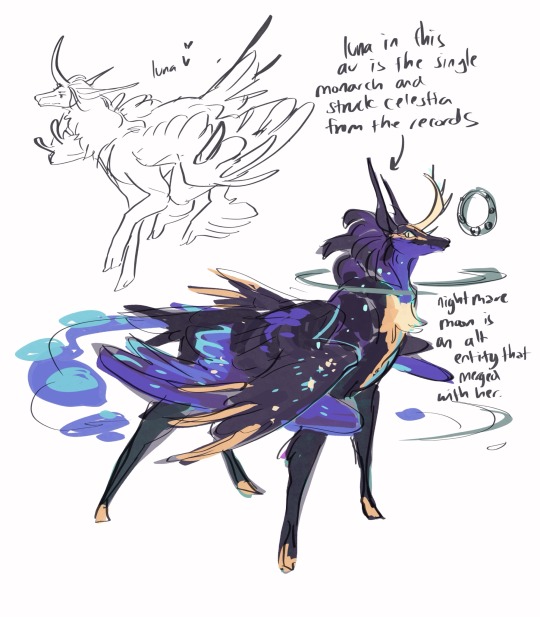
(The Selene Grace hates the sun monarch they deposed five centuries ago as they stay chained to their post, keeping the lunar and solar bodies from crashing into each other. Luna misses her sister, and the easier world where they haven’t hurt each other beyond reparation. Nightmare Moon misses their monstrosity, trapped in a host who’s grief has poisoned them with empathy.
Things are bound to tip. The celestial bodies are not bodies, but prisons, and the amalgamations we call alicorns the key. And something desperately wants to be freed…)
Anyways:
My mane 6 redesign here!
And my luna and celestia redesigns here!
#rest your weary hooves in our new found home#^pony tag nonsense!#omg what if i idly brainstorm toxic horse yuri#idk these characters beyond the first three seasons#they’re sandbox critters to me sorry if this is not lore accueate aHAHAHhahaaaa#anyways#au where celestia looses the fight with nightmare moon and ends up wandering the continent as an exiled god#luna gets her shit together but its A Struggle#and chrysalis is actually an elderitch entity similar to discord in this au (think the god of deception or something similar)#((deceptacons roll out))#celestia#luna#chrysalis#nightmaremoon wins au#critdraws#art#celestia/chrysalis#mlp au#i had to post this at somepoint and thought well now’s better then never#sorry for the sporadic posts and terrible replies life’s super busy rn but i have a lot of thoughts#i just need luna and celestia to be siblings that heal from wounding each other in terrible ways okay#and i thought ‘celestia and chrysalis would pbbly hate each other’#(neuron brain activates)#oh my god what if they hated each other#mlp#mlp redesigns#mlp celestia#mlp luna#mlp twilight sparkle#mlp chrysalis
709 notes
·
View notes
Text


[ID: a digital drawing of kristen and tracker from fantasy high cradling the moon. kristen's hand is on the dark side and tracker's on the light side. on kristen's side of the drawing are stars and she's holding a cowboy hat out of which are falling nacho chips and sauce, as well as wearing a 'kristen for president' sash. on tracker's side are snowflakes and coins, and she's holding a candy cane. additionally, there is a halo behind kristen's head. the second image is the reverse of the first. End ID]
#fantasy high#d20 fantasy high#kristen applebees#tracker o'shaughnessey#trackerbees#fantasy high fanart#fhjy#this is an ancient drawing that i've been futzing with on and off forever#so i decided to just go ahead and finish it bcs i DO like its bones and i wanna share it#smts u just can't be fully satisfied w a piece and it is what it is#in the original drawing they were fully naked but i ended up giving them clothes#even tho its a bit antithetical to both their characters but. i dont want to get yelled on the Internet ssjkdsk#anyway yes fhjy did finally make me ship them#all i needed was for them to break up and get into a v complicated and nasty situation#i dont ask for much. give me two medics going for a fist fight bcs they can't navigate their tender and sexually charged situation#just UGH. theres three kinds of relationships in fh that ive loosely categorized#no one is the gorgug/zelda situation which is kind of casual and 'ure there so lets make out' and it doesn't last beyond the first hurdle#no two is the ayda/fig where they'll a 100000% get married and stay together for the next 70 years#and no three is the kristen/tracker#they're going to have a quasitoxic on and off relationship for the next ten years and they'll either find the versions of themselves that#can coexist and be together if the stars align or they'll have such a horrid fallout that they'll never speak again by the end of it#amongst the children that is. the parents are way more complicated but also simpler
85 notes
·
View notes
Text
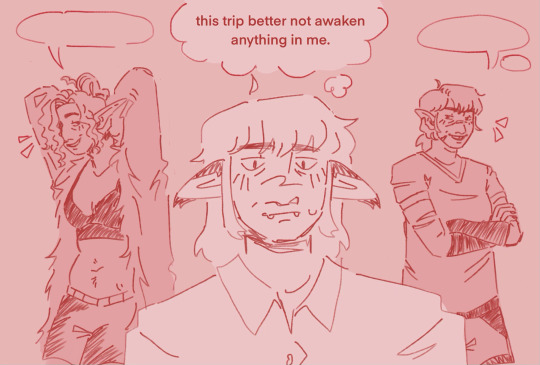
It probably won’t (it will)
#hallariel seacaster#sklonda gukgak#sandra lynn faeth#you guys don’t get it. the fallinel trip. the trip. something about the trip. (gesturing to an empty conspiracy board)#the world is ending and the only thing that can save us is three middle aged mothers in love with each other#but in like a weird way where they really probably shouldn’t date#I cannot express how funny I think it is to pretend Sklonda Gukgak has a crush on Hallariel Seacaster#they are absolutely not compatible in any way#sklonda watching hallariel start a house fire while making breakfast and thinking ‘I need to kiss that strange woman.’#they would never happen in a million years but that’s the fun of it#on the other hand Sandra Lynn and Sklonda are actually soulmates and it’s a wonder to me that they haven’t fallen madly in love yet#but I’m patient and hopeful#telling me anything about the fantasy high parentcule is like letting a starved cow loose in a maize field#you can’t just show me a bunch of deeply flawed middle age parents and expect me not to make them all kiss each other y’know??#fantasy high#d20#sklonda fantasy high#d20 fantasy high#dimension 20#d20 fanart#fh#d20 fh#fantasy high fanart#fhjy#the bad parents#polyamory#d20 fhjy#fantasy high junior year#undescribed#my art
340 notes
·
View notes
Text

I'll be forever mad that Jayce ruined the moment right there, but not because I think this would've been a perfect ending for them (I don't). I'm mad because if Jayce had just waited five fucking minutes, the resulting scene would've been so juicy.
Look at the way Vi and Cait look at each other here:
Caitlyn: shocked, betrayed, hurt

Vi just looks sad:

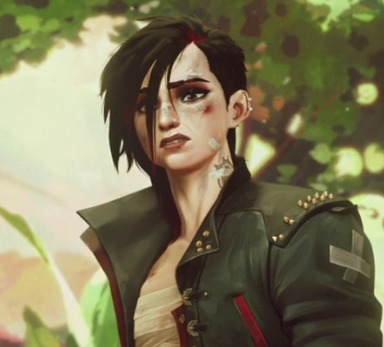
We know from their dialogue in ep 8 that while Vi and Caitlyn were making the plan to distract Ambessa, Vi had another one, to bring in Jinx as a contingency in case Caitlyn couldn't be trusted or failed. She had to know Caitlyn wouldn't take it well once she found out. Vi's priority n°1 was saving Vander though, and they likely didn't have much time to think this through. Basically, she had to know that from Caitlyn's POV, it would look like "Vi chooses Jinx over Cait", edition number 2.
And she was likely right! We know Caitlyn lets go of her anger towards Jinx in the next episode, and accepts that Vi has the right to choose her family, but in my opinion, she wasn't there yet in ep 6. Having a broken Jinx locked up in a cell (her single goal for the last few months) while Vi was lying unconscious on her bed for days very likely helped Caitlyn reassess her priorities in life. But here in this scene she literally doesn't have time to think!
Let's look at Caitlyn a bit more here. During their reunion, She probably expected Vi to hate her guts, but instead, Vi looks grumpy, calls her a mongoose and a cupcake in two sentences, and drops the "my dad needs help" bomb after hesitating for a hot, single second. Moments after that, Caitlyn reevaluates her life choices and decides to make a big career change. Plenty of great posts have already been made about Caitlyn's motivations there, but to sum it up, I'd say it was a combination of: her being already wary of Ambessa and not wanting to let a Noxian warlord get her hands on a dangerous weapon / innocent man, being tired of hating herself, and, yes, her feelings for Vi coming back to her in full force.
For a few, glorious moments, she was working with Vi again! Probably feeling more like herself than she had in months. Maybe she started to hope they could reconcile after all. Maybe, she hoped it could be a "do over" for their failed mission with the strike team, where she'd be helping a member of Vi's family, instead of being torn apart by one of them.
... only to find that Vi didn't actually trust her (which was deserved, but still, ouch), and to come face to face with the source of her seething hatred, the single object of her obsession in the last few months. Right after being saved by said source of seething hatred. It's a lot to take in. She had to be simultaneously disappointed and shocked
So, what was she gonna do? There was probably nothing Vi could have said that wouldn't have pissed Caitlyn off right then (no, Vi, saying "she's changed" probably wouldn't have helped), Jinx opening her mouth would have likely made it worse, but at the same time they still had to run away asap. Caitlyn had already betrayed Ambessa, she couldn't go back. Vi pretty much put her in a position where she'd have no choice but to follow along, no matter how angry she was, at least for a little while...
and I made this post just to say, that the resulting bickering would have been hilarious to see :S
(forget about Jayce waiting five minutes, though, what if it they had an hour? what would Caitlyn had done once they were far enough from the Noxian army? point her gun at Jinx? attempt an arrest? (right in front of Vander? gulp) she might have simply ended up separating from them, and that would have been heartbreaking enough, but a completely different story)
((and that's assuming cult member!vander would have just agreed to leave the commune without acting weird))
#arcane#arcane discussion#caitvi#arcane jinx#arcane vi#caitlyn kiramman#what was the point of this post?#none#everything that happened happened because there was a plot to move along#i just like thinking about alternative universes#want another one?#hey what if vi had died at the end of act II#what then#poor jinx looses vander and isha and vi all at the same time#ekko wouldn't have come back in time to stop her from pulling the pin#caitlyn looses vi at the worst possible time too#after thinking they could re conciliate but before they actually did#especially if you remember that in her last moments vi ditched her in the middle of a battlefield to sacrifice herself for jinx instead#=“vi chooses jinx” edition number 3#and vi never gets to be free of her family and choose what she really wants#true tragedy for all three of them
95 notes
·
View notes
Text


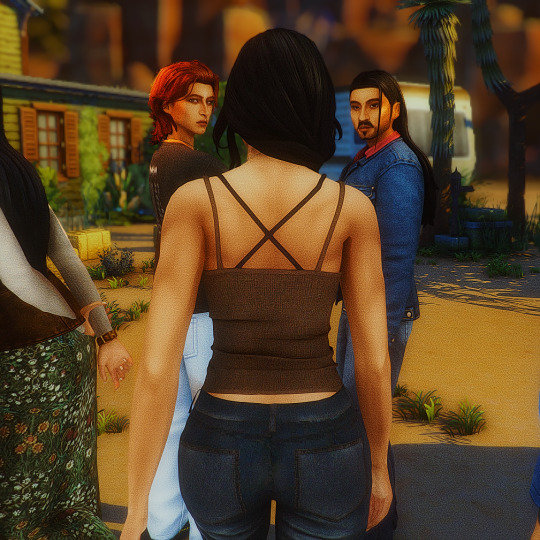

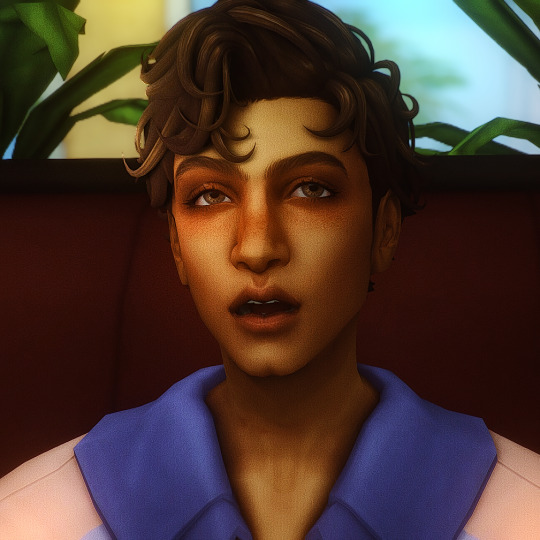

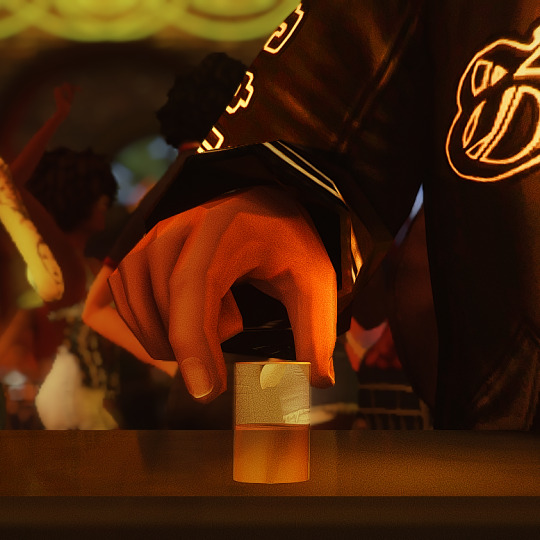
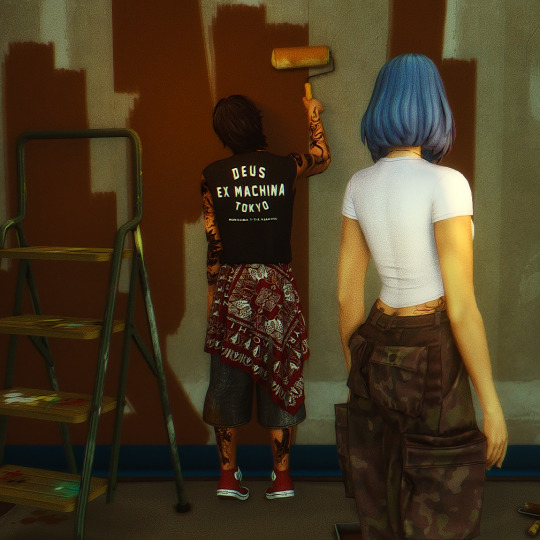
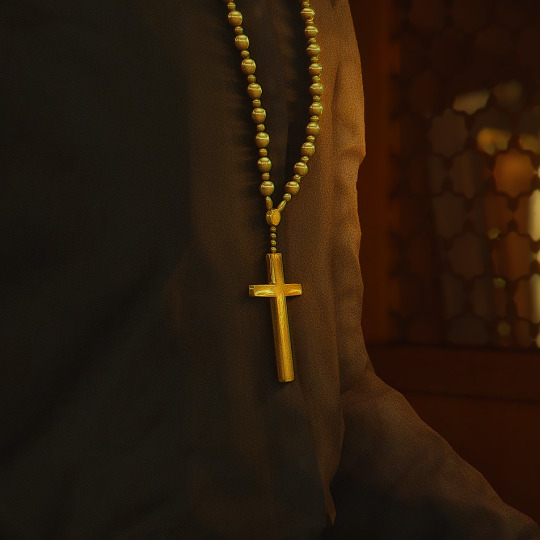

U_U ⋆。°✩
#i can fix them i say as i look at their story arcs#ahh onto november#i think we'll close out that month with the arts festival hopefully#month after that should be the sulani arc#then finally wrapping up some loose ends and beginning the white rabbit arc#miiiight bump up to three times a week depending on how complex some scenes are#but we'll see#tessellate: extras#ts4#simblr
71 notes
·
View notes
Text
varric is not a redhead anymore (the iron bull greatly disapproves)

#this is the last one i promise#dragon age the veilguard#dragon age#dragon age 4#varric tethras#had this one my mind since the announcement trailer but now that i had a friend agree with me i can post this without feeling like im#the only one loosing my mind#anyway also have made a discovery that thorin has a haunted look in his eyes for about the majority of three films. which is understandable#but weird that it took me so long to see it#also bioware why is varric not a redhead anymore (the iron bull disapproves)#like i get that he's a silver fox now and honesty good for him#but that doesn't mean his hair had to turn black#unless he's really going thorough it (the midlife crisis) and dyeing his hair while waiting for the world to end#which is also understandable#also idk how lotr years work so i just copied thorin's death year from wiki#tadi talk
114 notes
·
View notes
Text
Okay, I can’t be the only one who has a picture in my head of child Bruce being adopted by a fae, and almost stolen.
In my head, Bruce is like 9 or so at the time. I read somewhere that the fae tend to take kids sometimes to raise them or to have them as pets. So I’m imagining this super powerful fae who got attached to a child of like a witch or something, and is raising this kid in this weird in between place between the fae realm and human world.
So the kid probably explores and ends up finding Bruce and befriending him.(Maybe there’s an entrance to that dimension in the cave that becomes the Batcave, and Bruce is exploring.)
So Bruce is unceremoniously adopted by this sort of fae child and it takes a little while for either of their respective adults to notice. The fae notices and is debating whether or not they should take Bruce, but then Alfred notices.
Alfred is British, and the British have so many myths and stories about the fae, so there’s no way Alfred doesn’t become convinced they are about to doom his kid to a life as a slave.(Bonus points if this leads to Alfred having a tiny crisis about being Bruce’s father figure and not wanting to replace his parents)
I’m not 100% sure about the rest of the au, but I can clearly picture in my head the fae kid sitting with Bruce at a table, eating cookies, while Alfred and the Fae being have a ‘conversation’(I’m imagining that thing where character a is oblivious to character b and character c having a full out brawl.) Bruce and the Fae kid eat cookies while their respective guardians duke it out.
Years later, Bruce is asked by the kids about the iron brass knuckles in the cave, covered with something.
#bruce wayne#batfamily#alfred pennyworth#alfred pennyworth is the best#Bamf Alfred Pennyworth#child Bruce Wayne#I can think of three different endings#first is Bruce and fae kid are separated and the portal is destroyed#then years later they meet again#bonus points if Bruce is supposed to be a sacrifice#second ending is fae child and Bruce are raised by Alfred#and they grow up as siblings#it’s like the story where the woman takes both the changeling and her kid#Alfred gets a free slightly Eldritch child#the bat kids grow up with their magic aunt/uncle who teaches them about deals#the third option is Alfred and the fae raising the two like a bitterly divorced couple#this is my favorite#the fae kid doesn’t age very much#so the bat kids have an aunt/uncle who looks younger than them#who is very focused on their happiness and has a loose grasp on morals#what if Bruce promised never to kill a human being#and that is why he doesn’t kill#it would be so funny#especially if the justice league gets involved#this is better if it takes place in an assumed cryptid batfamily au
77 notes
·
View notes
Text
I love that we have all collectively decided that Jeremys French tutor is going to be suspicious. We literally know nothing abt this person, but bc theyre Not Jean teaching Jeremy French they earned immediate suspicion
#aftg#tsc#tgr#jean moreau#jeremy knox#jean and jeremy#tsc3#aftg tsc#aftg tgr#aftg tsc3#the rumors flying abt a character that hasnt even been introduced yet is insane#people are already like “what if theyre connected to the mafia”#guys we dont even have a name yet#for all we know book three ends with jeremy knowing german not french#i love it though#the insanity of it all#its gonna be so weird after book three comes out and its just over again#anyone still around from the og fandom?? i wanna know how you copes#what if nora goes completely dark again after book three comes out??#we all know this series is kinda traumatic for her and she has a lot of messed up feelings abt it so what if once she gets jeans story#out thats just it??#there is nothing tying her to it anymore#if she ties up all the loose ends then she can finally walk away free and never look back#what if she writes smt else#like a completely different series#what if she never mentions aftg ever again#i dont know what to do knowing we only have one more book coming out before we are back in the trenches again#im gonna stop rambling and get back to my homework but like... one more book is all we got left... damn
40 notes
·
View notes
Text
The vast majority of people who still follow this blog patiently waiting for me to post the final two chapters of a story I haven't updated in half a year, but I have been consistently updating for seven years.
Instead I'm working on the next chapter of a story I haven't updated in literally a decade which by this point everyone has basically given up on, so in a way, what's the point, but I guess I'm going to do it because why not?
#for those three people still holding out hope#that i would one day update it#your patience has paid off as a certain someone would say#personal#i have not abandoned bm but man tying up the loose ends on that story#in some ways is a bit of a chore
22 notes
·
View notes
Text
Season 8: Tying Up Loose Ends and Forging New Paths

(Credit: Everett Collection)
The recurrent themes of The X-Files are resolved by the close of Season 8-- a nice touch, even if the execution is unavoidably flawed.
THE CULMINATION OF 8 YEARS
In the Pilot, Mulder divulged that "the family" had been torn apart; and that his quest was to find his sister. He was searching for his family-- a family-- and thought "the truth" would give him closure. In the Pilot, Scully related that her parents considered her recruitment "an act of rebellion"; and in Beyond the Sea, The Blessing Way, Quagmire, Never Again, and all things, she further revealed a reticence (and fear) to trust her own instincts over "other fathers." She was searching for herself-- and came to hope that "the truth" would lead her to justice and peace.
In The Jersey Devil, Scully briefly expresses interest in a family, juxtaposing her desire for a "life" with Mulder's disinterest in one-- a parallel that pops up again, six years and an almost kiss later in Dreamland I. In Home, Mulder ruminates on a life like his childhood, sees his partner as a mother for the first time, and secures the door between his and her motel room-- reinforcing Scully's instincts: he isn't ready for a "normal life." In Quagmire, Scully recognizes, "You are Ahab"; in Never Again she rebels against "other fathers"; and in Milagro she affirms, "Loneliness is a choice." In Season 1, Mulder asserts, "I have a life"; in Season 6, Mulder learns to partake in "life on this planet" (and tries a cycle of IVF with his partner shortly thereafter); and in Season 7, Mulder turns away from "another life, another world" to appreciate one with his partner. Scully's ruminations on motherhood are brought to the fore with her infertility and Emily Sim's death: "a miracle that wasn't meant to be." Mulder joins her wishes with hopes of his own in Per Manum: "Never give up on a miracle." In Requiem, both are touched by Teresa Hoese's child; and he insists, "Looking at you tonight, holding that baby... knowing everything that's been taken away from you. A chance for motherhood and your health and that baby.... There's so much more you need to do with your life. There's so much more than this." Mulder is abducted and returned and turned out from the files while Scully is pregnant and head of the files and "retired" away from them. Both realized that "other worlds" and "other paths" only led them away from themselves and each other (The Unnatural, Amor Fati, and all things, respectively); and both found that the truth "out there" (e.g. alien abductions or ever-evolving conspiracies on the files) was secondary to the truth "in you."
Mulder follows the same journey as his father, Bill Mulder: compelled into an impossible position (by men or aliens) and returned a fractured person. However, Mulder broke the generational curse-- running past his own weaknesses to help others in pain; nearly dying to the same Conspiracy, and leaving the "truth" behind for his own son. Likewise, Scully follows the same journey as her father, Captain Scully: diving deeper into work to excel and escape, surfacing only when faced with an inescapable tragedy. But she, too, broke the generational curse-- proving her mettle on the files and leaving it behind to be there, fully, for her own child.
Fate and freewill are in constant battle until Existence's close: in Paper Clip, the files and Fate are tied by mythological forces ("I think it's about something we have no personal choice in. I think it's about fate") which other mytharc episodes (and Monday) re-emphasize. In Mulder and Scully's partnership itself, either fate or a fluke brought them together but freewill kept them by each other's side. Scully's pregnancy is cloaked with the same questions-- a miracle, an act of God, an agent of freewill?-- but destroys the "fated" narrative with its closing lines: "Maybe he isn't what they thought he was. That doesn't make him any less of a miracle though, does it?" Fate and freewill converge, resulting in an ordinary life created through an extraordinary partnership-- normal, whole, and the "proof" Mulder and Scully sought.
8 YEARS OF THROUGH-LINES

(Credit to: Entertainment Weekly)
MULDER'S JOURNEY
In Requiem, Mulder considers: "I don't know, maybe they're right. The FBI. Maybe what they say is true, though for all the wrong reasons. It's the personal costs that are too high. There so much more you need to do with your life."
In Three Words, Mulder admits: "I'm sorry. I don't mean to be cold or ungrateful. I just... I have no idea where I fit in. Right now. I just, uh... I'm having a little trouble... processing... everything."
In Existence, Mulder replies: "I don't know. Maybe it doesn't [end.]"
In Existence, Mulder acknowledges: "I think what we feared were the possibilities. The truth we both know" and embraces a new life.
SCULLY'S JOURNEY
In Never Again, Scully states: "This isn’t about you. Or maybe it is, indirectly. I don’t know. I feel like I’ve lost sight of myself, Mulder. It’s hard to see, let alone find in the darkness of covert locations. I mean, I wish I could say that we were going in circles, but we’re not. We’re going in an endless line - - two steps forwards and three steps back. While my own life is...standing still."
In Biogenesis, Scully asserts: "Mulder... look, after all you've done, after all you've uncovered-- a conspiracy of men doing human experiments, men who are all now dead-- you exposed their secrets. I mean, you've won. What more could you possibly hope to do or to find?"
In all things, Scully discusses: "What if there was only one choice and all the other ones were wrong? And there were signs along the way to pay attention to."
In Essence, Scully demands: "Look, Mulder, look, I can't take this! I can't live like this-- as, as the object of some unending X-File."
In Existence, Scully asks "Which [the truth] is what?" and forges a new path with her partner and child.
BONUS

SKINNER'S JOURNEY
In One Breath, Skinner insists: "I’m afraid to look any further beyond that experience."
In S.R. 819, Skinner confesses: "I always played it safe. I wouldn't take sides. Wouldn't let you and Mulder... pull me in. Not the kind of ally that I could have been."
In Deadalive, Skinner says: "I had no choice. He wanted me to kill Scully's baby-- Alex Krycek-- for the vaccine. It's the only way he'd give it to me; but I couldn't trust him. I couldn't do that to her."
In Existence, Skinner pays for his freedom in blood, breaking free from his constraints once and for all.
CONCLUSION

(Credit to: @thexfiles)
Season 8 is, I believe, best summed up by a Frank Spotnitz quote.
Jan. 2001
"Whatever happens-whether Mulder appears next season [Season 9] or not-something is coming to an end at the end of this season. There’s the Mulder abduction storyline, which gets resolved, and there’s also the Scully pregnancy story line that gets resolved. And I think a big chapter is going to close in those final two episodes. And the series will be different, whoever comes back for it-if there is another year. We’re still working out what that final story is, but there are a couple of elements that we know are going to be in there. And those two elements close the chapter.”
Thanks for reading~
Enjoy!
#txf#xf meta#x files#the x files#Scully#Mulder#William#Frank Spotnitz#S8#S9#thoughts#Season 8: Tying Up Loose Ends and Forging New Paths#Essence#Existence#Skinner#mine#The Jersey Devil#Home#Dreamland I#Never Again#all things#The Unnatural#Amor Fati#Per Manum#S.R. 819#One Breath#Pilot#Deadalive#Biogenesis#Three Words
11 notes
·
View notes
Text
for how much I talk about yuuji and sukuna here you'd think I cry over these two the most... but noooo it's megumi that keeps making me break down into an uncontrollable sobbing mess
#I'll be fine as long as I don't think about how every adult in megumi's life failed and abandoned him in the end#or how he keeps loosing ppl he cares about the most in the world#or how ppl only see him for his potential or curse technique#or how he only genuinely smiled THREE times in the manga OR#fushiguro megumi
46 notes
·
View notes
Text
Iyengar and the Portrayal of Class and Power in her Games.
Since its origin in 1974, Dungeons and Dragons has been used to tell multiple types of stories, all depending on the players at the table and the dungeon master at the head of it. Most of these games (and other Tabletop roleplaying games, of course) tend to have a central theme in common, which is the theme of power. Whether that be a power over the world, for example, a king or nobility or dragon terrorising the nation, or the gods having power, or anything in between those, power always comes into play. Especially when it is commonly argued that one person at those tables, the dungeon master, or the game master, has the majority of the power over the table (excluding dice rolls, obviously. Dice rolls are left to the whims of fate.).
There is one Game Master who portrays power in not only her games, but her characters, and she portrays it well. Though at times the way she portrays this power is often subtle and un-noticed, it is there; As intrinsic to her characters as the fact that they are alive, as threaded into the worlds she builds as the people (or even stoats!) that live in them. The way is not too heavy-handed, but it is not so subtle that you cannot see it, it is a delicate balance that she always manages to strike. I am of course talking about the Game Master of (most recently, at the very least) Candela Obscura; Tide and Bone, Aabria Iyengar. Though Candela Obscura is her most recent project (as of writing, 30/2/24), she is also known for her work on Dimension 20’s A Court of Fey and Flowers, Burrows End, The Ravening War, Pirates of Leviathan, and Misfits and Magic, as well as her appearances on Critical Role and being a main cast member of World Beyond Number. She is also widely regarded in all of these fandom spaces as (jokingly) ‘One of our own’, due to her frequent appearance on fanblogs. This is also sometimes colloquially referred to as ‘getting Quiddied’. Although Iyengar’s portrayal of power is always there, it is never more obvious than in Dimension 20’s A Court of Fey and Flowers.
Whatever you are imagining for A Court Of Fey and Flowers, times it by 10, add much more court drama, secrets, espionage, and one single, drugged-up, horny Grandfather who is all the worst parts of birds, and you might have something somewhat close. The table for this season of Dimension 20 includes frequently famous fliers (bird pun fully intended) such as Emily Axford (Lady Chirp Featherfowl), Brennan Lee Mulligan (Captain K.P. Hob), and Lou Willson (Lord Squak Airavis), as well as newcomers such as Surena Marie (Gwyndolin Thistle-Hop/BINX Choppley), Oscar Montoya (Delloso de la Rue), and Omar Najam (Prince Andhera), with Aabria Iyengar at the head of it, controlling all of their fae fuckery (both literal and metaphorical).
A Court of Fey and Flowers is Bridgerton on steroids, with magic and dice and eating feathers, and it is exactly as insanely wonderful as you think it would be. Interwoven with the romance inherent to the regency genre (BINX/Prince Andhera and Delloso de la Rue/K.P. Hob), there are themes of class and social standing, not only among the general population of the courts, but among their peers. This is there right from the beginning, in fact, as across the series illegitimate marriages, secret engagements, and whole secret children are revealed. Being the Game Master of this season, Iyengar portrays these struggles with a gentle touch and an ice-cold grip, never letting you forget that they are there, waiting to be shown, in the background.
In the very first scene we have with Axford and Wilson’s characters, we learn both must marry for power, which tips many off to the way this society works. Their Grandfather (portrayed by Iyengar), demands they marry for power. This move, on Iyengar’s part, is a masterful portal of class, and hints at the social standing the characters have in the show. Unlike every other character mentioned, these two do not belong to a court. The implications of needing to marry well so they are not tarnished and banished from future social events do not go unnoticed by the players or the audience. Axford and Wilson would both later go on to reveal their already secured, entirely inappropriate matches, and cause many issues for their Grandfather.
Another, darker moment of power is the power that the parents have over their children in this world. ‘Parents’ is a strong word for what some of these relationships are, ‘maternal’ being an even stronger word, so we will, for the purposes of this essay, say they are the people who watched over these characters as they grew and now hold power over them. Starting with the positive parental relationships, Marie’s character is shown to have a very unique relationship with their parents and family.
Unique in the fact that they are dead, and still holding power over her (in a somewhat positive way). Marie’s character’s grief spurs her to action on multiple occasions, at one point almost causing the end of her life through a power more powerful than grief. This is also down to Marie’s performance as BINX, her grief is interwoven with her character, holding court on her seat with her. Iyengar, several times, uses the care Marie’s character shows to her old family against her; Particularly in Episode 10, when she brandished a weapon for the first time against Najam’s Characters sister. The scene is incredibly impactful, as Iyengar cuts across to use the moment BINX (Marie) removes Andhera’s (Najam’s) shard to show Suntar (Andhera’s sister, Iyengar) losing the little power she had over Najam’s Character.
Though Suntar is not the only person who held power over Najam’s character, his Mother, the Queen of Air and Darkness (again, Iyengar) is shown to terrify them. In fact, the power The Queen holds over her son is so deeply rooted into his character, it is a part of his design, a shard shoved into his neck that rains on him when he gets upset, or any strong emotion. This allows Iyengar to offer reminders to the cast, even when Najam is portraying the emotions, that there is always someone more powerful than the main six out there, waiting. This impact is made even heavier by the fact Najam plays one of the most powerful characters at the table himself, a Prince of a court that is widely well known and highly regarded. There is a case to be made about how he might play the most powerful character at the table, because while Marie’s Character is the leader of their court, that court is diminished, and Montoya’s character still answers to other people.
Speaking of Montoya’s character answering to other people, The Chorus are some of the most prominent threats despite never being explicitly stated as villains (like characters such as Prince Apollo (Iyengar) are). They run one of the most powerful courts, The Court of Wonder, and help put together the entire event the story takes place in, The Bloom. The power they have over Montoya’s Character (Delloso de la Rue) is never unnoticed. It is integral to the character, given that they wore a glamour (a magical illusion to make them look like a green-skinned elf) every single day, to hide the fact they really are an owlbear, which are typically considered monsters. The Chorus only really exert their power once in a threatening way, but just because something is not said does not mean it is not felt. For example, Wuvvy (Iyengar) is a member of the Court of Wonder, and although she is Delloso de la Rue’s assistant, she is still a member of the Court of Wonder, which means she also answers directly to The Chorus if she is asked. Though all the examples mentioned so far are subtle in their power, one court likes people to know they have power, perhaps because the people in it are so very tiny.
Mulligan portrays Captain K.P Hob of The Goblin Court, which holds the most explicit power in the season. Before we have even learnt the name of Mulligan’s character, we learn he is a Captain, which might mean something in another, kinder universe. This ties back into the Goblin Court holding all the power, K.P is a captain of their court, and this is so important to him we don’t learn his first or second name until much later. Iyengar and Mulligan work together to portray the court gaining and losing power rapidly, and using its members with significant ranks to find and hold that power. This is shown when the Viscountess Grabalba marries the Head of the Trickster Court after her previous engagement is called off. It is shown, in a much more solemn light, when K.P Hob is promoted to Major and ordered to marry for the court, which he does.
There is also power in the way the cast chose to do their romances in this world, which Iyengar facilitates with several events throughout the ten-episode season, such as a Masquerade Ball and a Hedge Maze. There is power in the way Axford’s character has her own, secret family, in the way Wilson’s has a lover in every court, in the way Marie and Najam’s characters find each other, and in the way both Montoya and Mulligan’s leave their old lives behind for love (in Montoya’s case, in an almost direct parallel to Wuvvy). You could write an essay on the romances in A Court of Fey and Flowers, but this is an essay about power, and while love does have power, I would next like to discuss another Dimension 20 season headed by Iyengar and featuring Mulligan that heavily plays on power.
Dimension 20: Burrows End is Chernobyl (the TV show) meets Chicken Run (but replace the chickens with stoats) meets Peter Rabbit (but they are stoats) meets 1984 (but with stoats). There are a lot of stoats in this season. Almost every character is a stoat, with exception of the two named humans (one of whom is secretly a stoat). Again, this cast includes some frequent flyers, such as Brennan Lee Mulligan (Tula), Isabella Rolland (Lila), Siobhan Thompson (Jayshon), and Erika Ishii (Ava), as well as the transition of Rashawn Nadine Scott (Viola) from Play It By Ear to Dimension 20, and 3 Black Halflings’ Jasper William Cartwright (Thorn Vale). All in all, this cast is best described as a powerhouse.
Iyengar portrays class and power in this season in a subtler, more intimidating way. It is not so obvious at the beginning, as all the power seems to be in the hands of Cartwright’s Thorn Vale, the leader of an exclusive cult that worships The Blue. There is an argument to be made here that The Blue is the one with the power, despite not being a technical character in the season, it holds its place by being constant, whether that be through Cartwright and Scott’s character’s cult, or whether that is through forcing the beating of Mulligan’s character’s (Tula) heart. In this, the force which holds all the power is not a character at all; It is similar to what holds all the power in our world, which is simply nature.
When the main six reach a location known as Last Bast, or The Last Bastion of The Light, or Warren Peace Nuclear Power Plant (we’ll continue to refer to it as Last Bast), some of the first characters there that they meet have the least power. They meet the working-class of stoats first, before anyone else, and thus begin to see Last Bast from their perspective. They meet these working class stoats when they are dying, when it is implied they are expendable because they have no power. In reality, they have all the power, being the ones to provide the food for the rest of Last Bast, and being the ones to provide the food, which keeps the area going. In reality, as much as the ruling class don’t think the working class have any power here, they have all the power.
One of these working class stoats (as a reminder, these are all stoats) is an outspoken adolescent named Sybil, who loses her brother in the first meeting with the main six. Though initially she is portrayed as weak and powerless (literally being dead in her first appearance), we learn that she is resourceful, and if she is not strong in the literal sense, she is strong in the mental sense. She is also used to show the power that the leader, The First Stoats, have over their people, when they kill her in front of the Main Six to prove a point. Her death is explicitly described as being “The price of treason,” (Iyengar). Though Sybil is often argued as just simply being ‘a narrative device’, could the same not be said for all the characters in this story?
Sybil is also used to portray the idea of love conquering all, an overused trope but a trope for a reason. One of the most popular phrases in Last Bast, and a phrase used to guide other stoats towards it is “Follow your instincts towards the light.” Sybil takes this extremely literally, following her brother and breaking rules for her family, such as saying Curtis’s name even after he died (an act forbidden by The First Stoats).
Which brings me nicely onto the next point, the way The First Stoats attempt to hold power over death. The first way this is shown is through the disallowance of names for the dead, for the people who don’t technically exist anymore. This furthur shows their dictatorship and need for power and control; The way they cannot control death so they outlaw the names, taking away the family’s process of mourning and grief. The second way they do this is through Sybil’s aforementioned execution by them. They capture and kill her, showing again how they have the level of power and control that other stoats in Last Bast do not have.
Candela Obscura; Tide & Bone is not only a masterclass in relationships and trust between players at the table, but a masterclass in power. The cast includes Sam Riegel (Oscar Grimm), Noshir Dalal (Professor Rajan Savrimuthu), Gina Darling (Madam Cordelia Glask), Ashly Burch (Dr Elsie Roberts), and Liam O’Brian (Professor Cosmo Grimm). This cast includes Critical Role old and new friends, all voice acting powerhouses in their own right, and is headed, as all these tables are, by Aabria Iyengar.
Tide & Bone does not only choose to focus on the power of human emotions, but on the power of nature, and the freakish things we cannot control even when trying our best. To understand the portrayal of power in this game, we first need to understand the characters and their relationships to each other, since one of the long-standing themes across the circle is what power, and how much power, do our emotions have over us?
This theme is most obviously portrayed through Burch’s performance as Dr Elsie Roberts, a young Doctor with Cullet and a panic disorder that materialises as a terrible monster when she gets too stressed (take it literally), and Dalal’s performance as Professor Rajan Savrimuthu, a professor with a hive in his chest. I highlight these two not because they are the only people to portray the theme of emotions holding more power than they are worth, but because they are the most obvious. It is well stated that the professor and the doctor were together (romantically), “For a time.” (Burch).
The scene that highlights this the most is the opening scene to Episode 3, Candles in The Dark, where it is revealed to the audience that, for an unknown reason, Professor Rajan Savrimuthu spent the whole night outside Dr Elsie Robert’s bedroom door, after him leaving in the previous episode. This scene, or the opening to it, shows how people are easily manipulated by their emotions, especially people such as Professor Savrimuthu and Dr Roberts.
This theme is further explored later in the scene with the line “(Oscar) is interesting. He has certainly earned your trust.” Said by Dalal as Professor Savrimuthu. Oscar Grimm is one of Dr Robert’s best friends, and the only person to have ever seen her transform into the beast outside of herself (“I would have seen it before, right? So I know.” (Reigel as Oscar Grimm, narrating his internal monologue.)). This is further questioned by Dr Roberts, when she wonders why exactly ‘Raj’ is choosing to bring up this moment now, when they are about to go on the run, saying Elsie’s internal monologue is asking “Is this an inopportune moment of jealousy? What’s going on here?”.
However, romantic emotions are not the only emotions shown to have power over people. When Dr Roberts transforms into The Beast for the first time on-screen in Episode 1, it is not Professor Savrimuthu who comforts her through it, it is (one of) her best (and only) friends, Oscar Grimm. ‘Comforts her through it’ is a generous term to say ‘he is the one who takes the fall, not only for Elsie but for the rest of their circle, as she kills him’. Oscar Grimm cannot die, but he can still be killed, and he is. As he is being killed, though knowing she cannot hear him, he whispers, “It’s ok. I’ll be fine.” and then promptly dies and comes back.
This is another way that Iyengar portray’s power in this story; The power of death, and those who defy it, through Oscar Grimm, Empress Iomene, and Cosmo Grimm. While many other themes are ran rampant throughout their story, the main one is death and mourning, and finding power over those things.
For Oscar, the man who never dies, death is not something to fear. He cannot comprehend or remember what happens when he dies, and though he is often not alone, he dies far more than any one person should. Both him and his son, Cosmo Grimm, have power over death in separate ways. Whilst Oscar does not actively seek death, it seeks him, and he keeps coming back, whereas Cosmo actually seeks death and does not find it. The constant death for the elder member and the constant undeath for the younger one make this duo interesting and give them some of the most power in this circle.
The last character to explore power in a unique way in this circle is Gina Darling’s Madam Cordelia Glask. She shows us the power of the gods, who took her entire family from her. Darling also, during her portrayal of Glask, holds a necklace like a rosary, showing how she still has faith in the gods that raised her and ripped her family from her. This point also further proves the power that our childhoods hold over us, even when we are in a different location, as Glask is.
There are then the themes of communal power that are portrayed in the story, most obviously the power of names and titles. In Newfaire, there is a literal divide between the Eaves and the rest of the city, the literal divide being the staircase into the Eaves. This is evidenced in the circle by the fact that only one of them is not titled in any way shape or form; That person also being the eldest in the circle, Oscar Grimm. Whilst all the other characters are titled somehow, with either Professor or Doctor, offering academic achievements, or Madam, offering social achievements. This creates a divide in the circle, which is particularly emphasised when you realise that Oscar works for Madam Glask.
In conclusion, although power has multiple meanings, somehow Iyengar is able to portray all of them across the games she leads. This essay only covers the elements of her games, it mentions nothing of her characters, the ones who destroy themselves for power (Suvi and Laerryn) and the ones who let power destroy them (Karna). Power, as most things are, is a storytelling device that can often be overused. Iyengar does not do that. Iyengar’s take on power is refreshing, and in so many words (3410 to be exact), oddly comforting.
#DONT LET YOUR LOCAL NERD LOOSE THIS IS THE RESULT#dimension 20#candela obscura#a court of fey and flowers#burrows end#yes this only covers three of them#i did the three i know best#delloso de la rue#K.P Hob#binx choppley#prince andhera#lady chirp featherfowl#lord squak airavis#thorn vale#viola burrow's end#tula burrows end#jaysohn burrow's end#lila burrow’s end#ava burrow’s end#rajan savarimuthu#elsie roberts#madam glask#cosmo grimm#oscar grimm#i wanna write one about the relationships in candela.#SOON
51 notes
·
View notes
Text
#yes this is about finding new friends for Hamid#there's a secret fifth option that is very funny but would require three new mice#and while I'd love to expand the cage even more one day i think for now i can only house three mice in total comfortablly#and in the end it'll all depend on what the mice look like when i meet them#duck talks bullshit#there's mice loose in Baker Street
134 notes
·
View notes
Text

making a c2c (corner to corner) crochet blanket of an ajr album (bc i must keep my hands busy at all times)
i think the colors should give away which album art im doing :)
#just the background tho#the pixels for including the three bros would've been not as detailed as i would've liked :(#but the background art is still really cool looking#there's going to be sooo many loose ends to sew in at the end 😭😭😭#ajr#rogerartz
14 notes
·
View notes
Text
Wait I'm naked??? WHERE IS MY SUIT?? ALL MY UPGRADES??
I DONT EVEN HAVE THE MORPH BALL?????
#NOOOO#USUALLY YOU LOOSE ALL YOUR UPGRADES AT THE BEGINNING NO TOWARDS THE END!#aeroigajeoirgjaeoijg#that is so cool more seriously#also this is the first time I play as Samus without the armor!! And probably the only time unless other metroid games after ZM try that too#Ah wait no it actually happened in the first one kinda i remember#though it was more a mode#it only happened after you beat the game under three hours#I wonder if this is a reference to that mode
17 notes
·
View notes
Text
making it a goal of mine to finish any one of the mayzuke oneshots i have sitting & collecting dust in google docs within the near future...
#nettsy rambling#my leading contender is probably like#one (three technically?) fic draft where zuke does may's skincare#<- loosely based off of that one official art of zuke vacuuming with that facial mask on#<- also supposed to be a thing where he takes care of may coz she sort of struggles to take care of herself#not that she DOESN't take care of herself... it's just that may generally lives fast-paced and 'in-the-moment'#(reasons related to being Technically homeless after storming out of her old home & having to bounce around from place to place)#and going Over The Top with hygiene is something that tends to miss her mind#combined with the chaotic lifestyle of musicians who aim to make a living off of their music...#it's something that can really wear a person down#—may can use some extra spoiling!!!!#PLUS. i headcanon zuke as VERY strictly conscientious of his physical wellbeing as a result of his chronic pain#and that awareness has sort breached him and overflown onto may#so he takes matters into his own hands!!!!#one big excuse to write lots of zuke fussin over his stubborn ass bandmate and being physically affectionate in his own 'justifiable' way#very very fluffy fic#Hehehehe 😆😆😆😆😆😁😁😁😁 Heeheh bhee. hhasaaaa Aaggaggagaa!!!! jjjj 😆😆😆😆😆😆😆😆😆😆😆😆#GET OUT OF MY HEADDDD GET OUUTTAA MY HEAD#i have like. a couple more. including a wild Elliegator chase thing & mayday and zuke hide a dead body#(the latter of which i MAY end up turning into something more because i thought of a good premise)#BUT ANYWAYS
7 notes
·
View notes